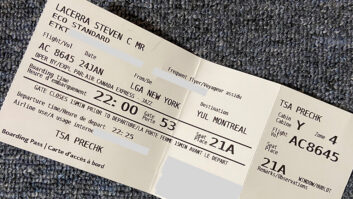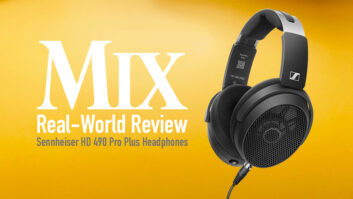Choosing the Best Cable for Your ApplicationOne of the most cost-effective ways to improve a recording setup or live sound system is to upgrade the cables. Microphone cables, patch cords, multicores and return snakes are all critical to a system’s overall performance. Even the best cables can wear out or become damaged when in constant use, and bad cables lead to down time and lost performances.
Many criteria are used to judge cable types and brands, but let’s focus on materials and construction, which include conductivity and shielding and operational concerns, such as sonic quality, flexibility, durability and reliability. Cost is important, but you don’t need to read this article to find the lowest-cost cables. Finally, appearance is worth considering, but appearances can be deceptive. It’s important to understand the difference between the “look” of quality and actual quality construction/materials.
MATERIALS AND CONSTRUCTIONIn general, the more copper in a cable, the better its conductivity. While copper has a certain amount of resistance to signal flow, steel and aluminum have significantly more. This resistance dissipates in the form of heat, one reason why steel and aluminum alloys are used as heating elements in toasters but not as signal conductors in cable. However, cable manufacturers sometimes use aluminum wire clad in copper for the center conductor, a design that improves performance while reducing cost.
Cable must be matched to the electrical load, and the more electrons you need to move, the larger the conductor. Unlike instrument and mic cables, which typically carry currents of only a few milliamps or less, speaker cable has to move a substantial amount of electrical current. For instance, a 600-ohm input driven by a line-level output only pulls about 2 mA, whereas an 8-ohm speaker driven by a 100-watt amplifier will pull about 3.5 amps of current.
Resistance limits current flow, and even pure copper conductors have a certain amount of resistance. If a cable with a resistance of 1 ohm is connected to an 8-ohm speaker, the load seen by the amplifier is 9 ohms. That translates to a power loss of more than 10%. Long cable runs add resistance and further decrease current transfer.
This brings us to “damping factor,” referring to an amp’s ability to accurately move a speaker cone. When we hear tight, punchy bass, it means the amp is accurately moving the speaker cone. The higher the amp’s damping factor, the better it can control the speaker. As the resistance of the cable can impede the damping factor of the amp, we say that it lowers the damping factor. This is why speaker cables work best with larger wire gauges. According to the AWG (American Wire Gauge) system, conductor area doubles with each reduction of three in AWG. For example, a 13 AWG (13-gauge) conductor has twice the copper of a 16 AWG conductor, while 10 AWG has twice the copper of 13 AWG, and so on.
SHIELDINGThe conductors inside a cable need to be shielded from noise, of which there are two distinct types. The first is handling noise, which can take the form of the crackling, scratching, popping, buzz or hum that’s heard when the cable is plugged in, but there is no audio signal. Handling noise can be due to bad electrical termination at the connectors, inferior wiring or worn or partially broken center conductors.
The second type of noise is interference – again, with two common types. Radio frequency interference (RFI) is caused by very high radio band frequencies. You may actually hear a radio station through your speaker with this type of interference, or it may just be high-pitched squeals or hiss. Electromagnetic interference (EMI), usually heard as low-frequency buzz or hum, is caused by transformers, power lines and other devices that use or transport large amounts of electrical current.
To protect against RFI and EMI, audio cables require shielding. As loudspeaker signals operate at a much higher voltage than mic or line level, the signal-to-noise ratio is vastly better, and RFI and EMI noise picked up by a speaker cable is virtually inaudible, or at least tolerable. In fact, shielding in speaker cables causes a nasty effect known as system oscillation, so speaker cables are not commonly shielded.
There are essentially three types of shielding used in different combinations, depending on whether the goal is to eliminate RFI or EMI. In descending cost of construction and materials, they are: braided wrap, spiral wrap and foil wrap with drain wire.
Braided shielding consists of copper strands woven into a braid pattern. An inner insulator jacket surrounds the center conductor, and the braided shield wraps around this inner jacket. Thanks to its low inductance, braided shielding works well for microphone cables. But due to the small holes between the braid’s pixels, the cable is slightly susceptible to RFI and cannot give better than 96% shielding. However, EMI is effectively eliminated, as the process of counter-wrapping the two groups of strands creates a closed circuit impervious to electromagnetic interference. Braided cable is the best type of shielding, but a dense braid tends to reduce overall flexibility.
Spiral wrap shielding is more flexible than braid and is commonly used for instrument cables. Lying flat, spiral wrap rejects RFI, but when the cable is looped, one side of a spiral wrap cable compresses while the other separates, like a Slinky toy; RFI can enter between the separated strands. Also, when looped, spiral wrap becomes a coil that can act as a pickup for EMI.
To compensate for less-than-ideal RFI rejection, some companies use a spiral wrap as a secondary shield, which employs carbon as a semiconductor. (In this context, a semiconductor is one that only works over very short distances.) Rather than being formed as a solid sheet, the carbon shield is made up of microscopic bits of carbon mixed into another, more flexible material. The carbon conducts current from bit-to-bit, and the spiral wrap effectively shorts out each semiconductor’s bit-to-bit transfer, effectively guarding against RFI.
To reduce costs, some manufacturers produce cable with less than 50% coverage in the spiral wrap, which improves flexibility but makes the cable more vulnerable to interference. With only a 50% coverage ratio, a spiral wrap cable is heavily reliant on the semiconductor layer to short out induced EMI.
Foil wrap shielding is the least expensive of the three methods, and it is 100% effective against RFI. A drain wire, which runs next to the foil, works the way a spiral wrap does but without the EMI susceptibility. Foil wrap shielding is most often used in the construction of multicore cables or snakes.
CONNECTIONSAlthough this article is primarily about cable, connectors are also important. Ideally, all plugs should have a copper center conductor. If possible, open the connector and check for quality soldering. Ensure that there are no blobs (too much solder) and no contamination from loose braid wires. The solder should have a smooth, slightly shiny surface. A dull solder joint usually results in a poor connection. Another technique – ultrasonic welding – vibrates the center conductor and the connector together at a high speed while being compressed, causing them to actually intermingle and become one. The process results in a very strong and highly conductive termination.
OTHER FACTORSCables can and do color the sound of the audio they carry. The reasons for this are complex, but some coloration is inevitable. Given that, it makes sense to choose a cable that sounds “good” rather than “bad.” Of course this will depend on taste, and subjective terms like warm, dark, flat, punchy, tight, thin, open and boomy are perfectly valid descriptions of the effect. Also note that it’s important to listen for noise and hum, both with and without a signal present.
Durability and flexibility are interrelated – more durability may mean less flexibility, and vice versa. Durability will depend on the quality and strength of the wire termination, the strain relief, the outer jacket and the materials used inside the cable. The conductor sizes and shielding type affects a cable’s durability and flexibility, though thicker cable is not necessarily less flexible. A thicker-than-usual cable may feature a double-thickness outer jacket, which can actually increase the cable’s flexibility.
A cable’s useful life depends on how and where it is used. Instrument and mic cables are often subjected to foot and wheel traffic, which can shred many types of shielding, internal insulation and even the center conductors, all without causing noticeable outer jacket damage. Dirt is extremely abrasive, so multicore snakes should be cleaned, particularly after outdoor events. Regular testing and inspection of cabling systems can detect problems before they develop, and an inventory of cable types/lengths helps determine if and when cable replacements should be scheduled. Cost is also a factor, but even a small budget can be maximized by making an informed buying decision.







